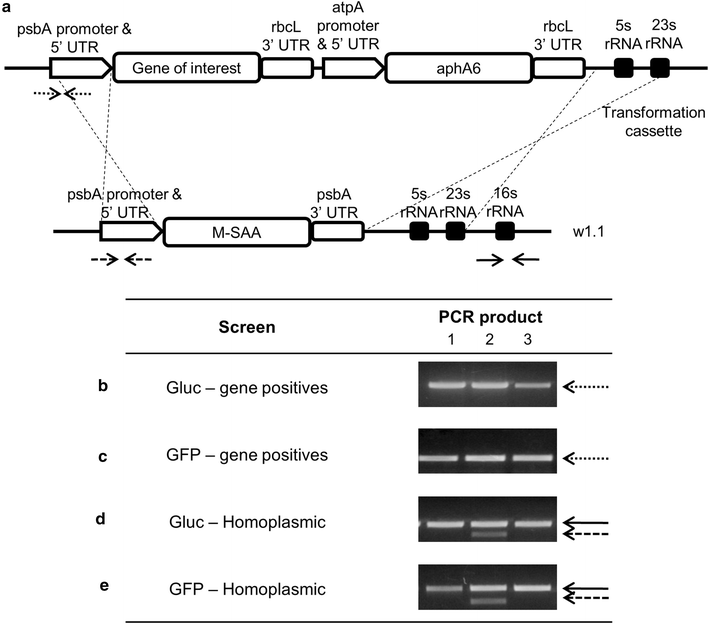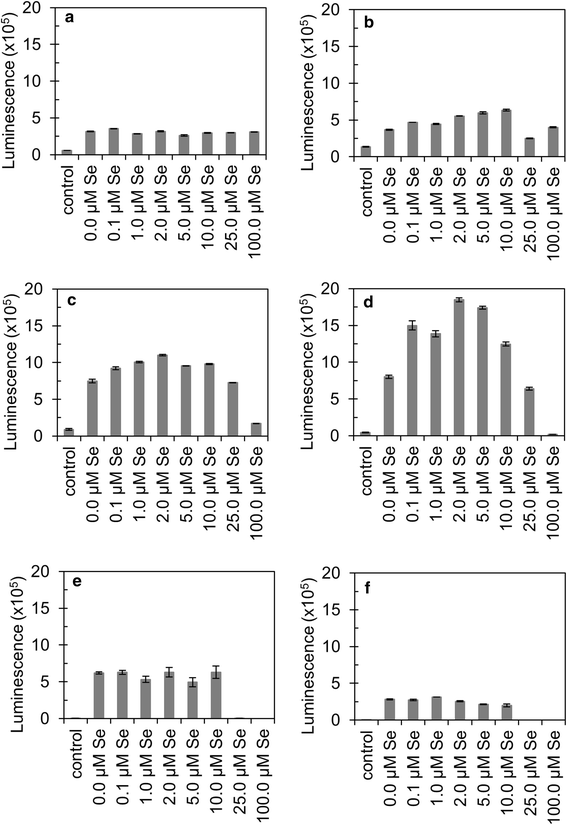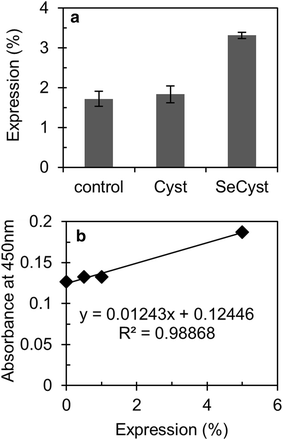Selenocystamine improves protein accumulation in chloroplasts of eukaryotic green algae
- PMID: 26137911
- PMCID: PMC4489976
- DOI: 10.1186/s13568-015-0126-3
Selenocystamine improves protein accumulation in chloroplasts of eukaryotic green algae
Abstract
Eukaryotic green algae have become an increasingly popular platform for recombinant proteins production. In particular, Chlamydomonas reinhardtii, has garnered increased attention for having the necessary biochemical machinery to produce vaccines, human antibodies and next generation cancer targeting immunotoxins. While it has been shown that chloroplasts contain chaperones, peptidyl prolylisomerases and protein disulfide isomerases that facilitate these complex proteins folding and assembly, little has been done to determine which processes serve as rate-limiting steps for protein accumulation. In other expression systems, as Escherichia coli, Chinese hamster ovary cells, and insect cells, recombinant protein accumulation can be hampered by cell's inability to fold the target polypeptide into the native state, resulting in aggregation and degradation. To determine if chloroplasts' ability to oxidize proteins that require disulfide bonds into a stable conformation is a rate-limiting step of protein accumulation, three recombinant strains, each expressing a different recombinant protein, were analyzed. These recombinant proteins included fluorescent GFP, a reporter containing no disulfide bonds; Gaussia princeps luciferase, a luminescent reporter containing disulfide bonds; and an immunotoxin, an antibody-fusion protein containing disulfide bonds. Each strain was analyzed for its ability to accumulate proteins when supplemented with selenocystamine, a small molecule capable of catalyzing the formation of disulfide bonds. Selenocystamine supplementation led to an increase in luciferase and immunotoxin but not GFP accumulation. These results demonstrated that selenocystamine can increase the accumulation of proteins containing disulfide bonds and suggests that a rate-limiting step in chloroplast protein accumulation is the disulfide bonds formation in recombinant proteins native structure.
Figures





Similar articles
-
Development of a GFP reporter gene for Chlamydomonas reinhardtii chloroplast.Plant J. 2002 Jun;30(6):733-44. doi: 10.1046/j.1365-313x.2002.01319.x. Plant J. 2002. PMID: 12061904
-
Engineering the chloroplast of Chlamydomonas reinhardtii to express the recombinant PfCelTOS-Il2 antigen-adjuvant fusion protein.J Biotechnol. 2018 Jan 20;266:111-117. doi: 10.1016/j.jbiotec.2017.12.015. Epub 2017 Dec 19. J Biotechnol. 2018. PMID: 29269249
-
Production of unique immunotoxin cancer therapeutics in algal chloroplasts.Proc Natl Acad Sci U S A. 2013 Jan 2;110(1):E15-22. doi: 10.1073/pnas.1214638110. Epub 2012 Dec 10. Proc Natl Acad Sci U S A. 2013. PMID: 23236148 Free PMC article.
-
Oxidative folding in chloroplasts.Antioxid Redox Signal. 2013 Jul 1;19(1):72-82. doi: 10.1089/ars.2012.4582. Epub 2013 Jan 4. Antioxid Redox Signal. 2013. PMID: 23289792 Review.
-
Substrate recognition by the protein disulfide isomerases.FEBS J. 2007 Oct;274(20):5223-34. doi: 10.1111/j.1742-4658.2007.06058.x. Epub 2007 Sep 24. FEBS J. 2007. PMID: 17892489 Review.
Cited by
-
The Potential for Microalgae as Bioreactors to Produce Pharmaceuticals.Int J Mol Sci. 2016 Jun 17;17(6):962. doi: 10.3390/ijms17060962. Int J Mol Sci. 2016. PMID: 27322258 Free PMC article. Review.
-
New tools for chloroplast genetic engineering allow the synthesis of human growth hormone in the green alga Chlamydomonas reinhardtii.Appl Microbiol Biotechnol. 2016 Jun;100(12):5467-77. doi: 10.1007/s00253-016-7354-6. Epub 2016 Feb 18. Appl Microbiol Biotechnol. 2016. PMID: 26887319 Free PMC article.
References
-
- Beld J (2009) Small molecule diselenides as probes of oxidative protein folding. Dissertation, Eidgenössische Technische Hochschule ETH Zürich. http://dx.doi.org/10.3929/ethz-a-005950993 - DOI
Grants and funding
LinkOut - more resources
Full Text Sources
Other Literature Sources
Research Materials

